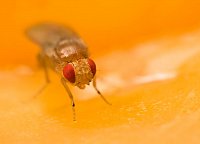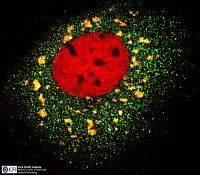Contact
Prof. Dr. Elmar Wahle
phone: 0345 5524921
ewahle@biochemtech.uni-hall...
Institute of Biochemistry and Biotechnology
06099 Halle (Saale)
Login for editors
Why the Drosophila only has one posterior
Melanie Zimmermann
Was happens to a cell when the RNA of the hepatitis C virus enters the cell and recruits the cell’s proteins for itself? What does the localisation of m(essenger)RNA have to do with the synthesis of new proteins? And which protein cocktail is necessary to prevent Drosophila from having two posteriors? Scientists from the Martin Luther University have been working on finding answers to these questions since 2007 as part of the national DFG project “Cytoplasmic regulation of gene expression” (FOR 855). The German Research Foundation (DFG) has earmarked 3.8 million euros to fund the research group in this, now second, funding period.

Drosophila (Fotolia, Studiotouch)
Genes – a type of biological hard drive – carry our genetic information and determine what happens in an organism. The common understanding is that the information in the cell nucleus is copied and transported via mRNA into the cytoplasm where proteins are synthesised. Gene activity at the right time and to the right extent determines the well-being of an organism. The regulation of gene activity is thus of fundamental interest for science, particularly since completely new regulation mechanisms have recently been discovered.
Proteins regulate protein production
Not only is the production of mRNA in the cell nucleus, but also its use in cytoplasm, subject to biological controls. Not every mRNA is used to produce a protein – small regulatory RNA (mi(cro)RNA, s(mall)i(nterfering)RNA) and RNA-binding proteins regulate if, when and where the mRNA are “decommissioned” or used as building plans for the synthesis of proteins in the cytoplasm.
Researchers from the MLU, Prof. Dr. Elmar Wahle, Prof. Dr. Sven-Erik Behrens – both from the Institute of Biochemistry and Biotechnology – and Prof. Dr. Stefan Hüttelmaier from the Faculty of Medicine are studying these regulatory mechanisms in three of FOR 855’s twelve sub-projects.
Why Drosophila only have one posterior
Elmar Wahle, together with group spokesperson Prof. Dr. Utz Fischer from the University of Wurzburg, is studying embryos of the common fruit fly Drosophila melanogaster. “It has already been determined in the Drosophila’s unfertilised eggs that the larva will have an anterior and a posterior,” explains Wahle. “Very stable protein complexes regulate where and when the development of certain mRNA occurs or is repressed in the embryo.” In the “normal case scenario” this leads to the larva developing a head and a body. If the regulatory mechanism is disrupted, the larva develops two heads or bodies that are arranged as mirror images.
Wahle’s team has so far been able to identify diverse proteins in the complex that are responsible for this repression. His colleagues have been able to engineer a “two-bottomed Drosophila” in the lab. “Our aim is to find out which proteins participate in the repression and the degradation of the mRNA at the place in the body where a certain body part isn’t supposed to appear and to find out why this happens.”
Sneaky cell robbery
Institute colleague Sven-Erik Behrens is studying the influence of viral infections on cells using the RNA virus hepatitis C (HCV) as an example. “The genome of the HCV is so similar to our mRNA that the viral RNA molecule imitates the mRNA and is able to bind to some cellular proteins, in other words, it recruits these for its own reproduction,” explains Behrens. On the one hand, cellular proteins are to be identified which serve as the virus’s host proteins. On the other hand researchers would like to find our how this impacts the processes within a cell.

ZBPs (zipcode binding proteins) help protect mRNAs from degradation in tumours and, together with these, localise into “stress corpuscles” (Foto: MLU)
Zip code for memory formation
Stefan Hüttelmaier from the Faculty of Medicine is studying the regulation of the localisation of certain mRNA and the production of proteins that is “bound to one place”. There is a group of proteins, (zipcode binding proteins) that have sections (domains) which certain mRNA are bound to. “The ZBPs are able to transport the mRNA to specific places using this method, for example the offshoots of nerve cells (dendrites), so that proteins can be synthesised there,” adds Hüttelmaier. These locally produced proteins are directly associated with the formation of synapses and are partially responsible for the formation of memory and the development of neuronal networks.
This shows that information alone isn’t everything – its utilisation is just as important.
